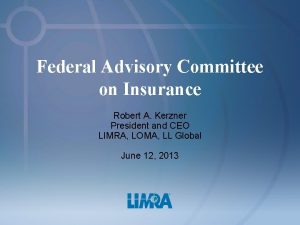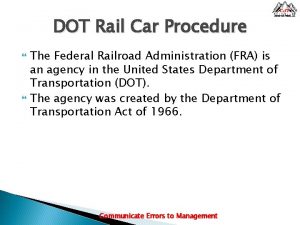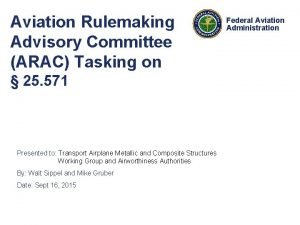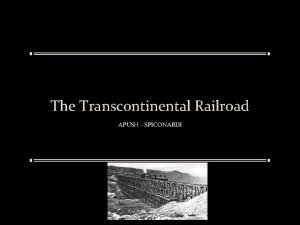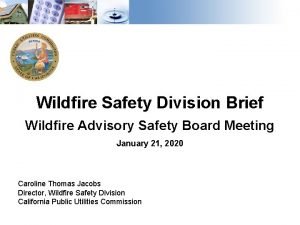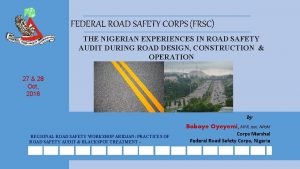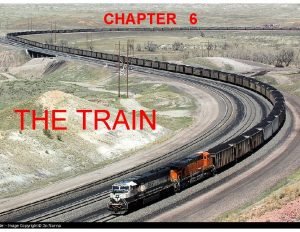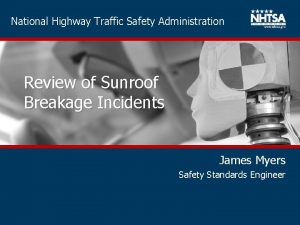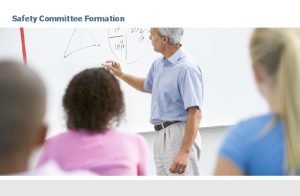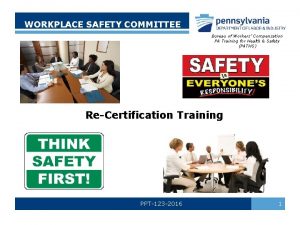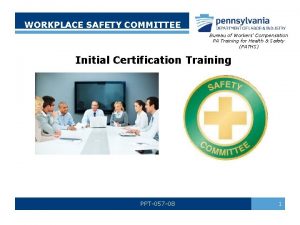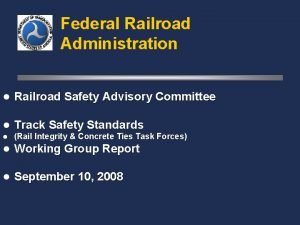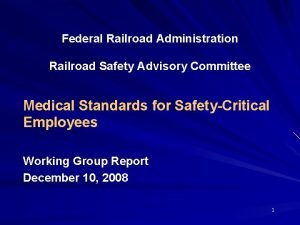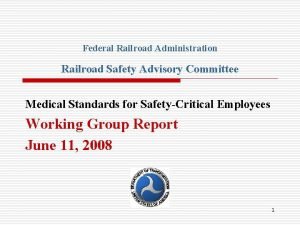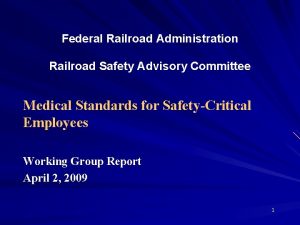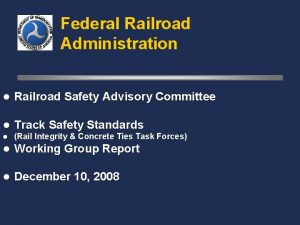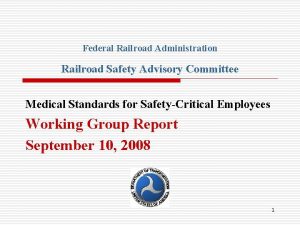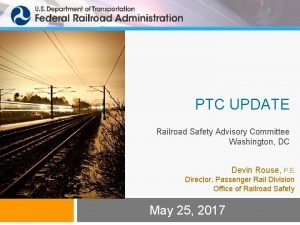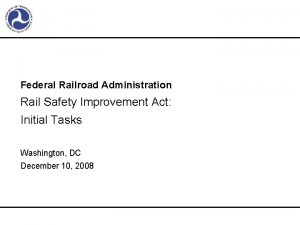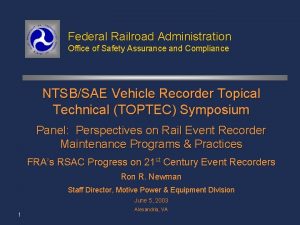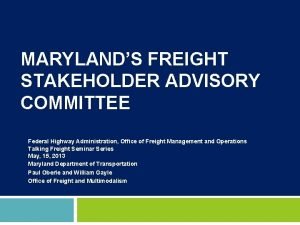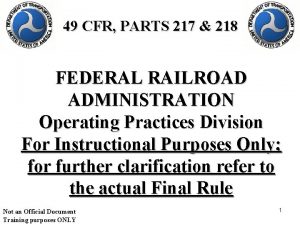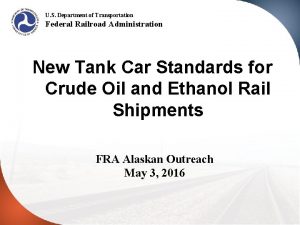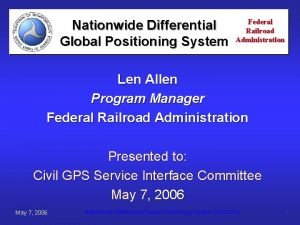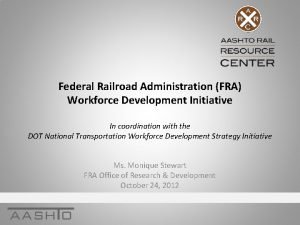Federal Railroad Administration Railroad Safety Advisory Committee The


































- Slides: 34

Federal Railroad Administration Railroad Safety Advisory Committee The RSIA Hazmat PPE Initiative The EEBA Rule June 25, 2009 1

Federal Railroad Administration Railroad Safety Advisory Committee The RSIA 2008 Hazmat PPE Initiative - June 25, 2009 The Railroad Safety Improvement Act of 2008 contained the following language: “Not later than 18 months after the date of enactment of the Rail Safety Improvement Act of 2008, the Secretary of Transportation shall prescribe regulations that require railroad carriers— (1) to provide emergency escape breathing apparatus suitable to provide head and neck coverage with respiratory protection for all crew members in locomotive cabs on freight trains carrying hazardous materials that would pose an inhalation hazard in the event of release; (2) to provide convenient storage in each freight train locomotive to enable crew members to access such apparatus quickly; (3) to maintain such equipment in proper working condition; and (4) to provide their crew members with appropriate training for using the breathing apparatus. ” 2

Federal Railroad Administration Railroad Safety Advisory Committee The RSIA 2008 Hazmat PPE Initiative - June 25, 2009 Work began in late 2008 to: o Review available information n n o hazardous materials carried by railroads that would pose an inhalation hazard in the event of release, Technical capabilities of available emergency escape breathing apparatus Develop rule text describing the proposed FRA requirements. 3

Federal Railroad Administration Railroad Safety Advisory Committee The RSIA 2008 Hazmat PPE Initiative - June 25, 2009 Some definitions: What is an EEBA? Emergency escape breathing apparatus (EEBA) means an atmosphere supplying respirator device that is designed for use only during escape from hazardous atmospheres. 4

Federal Railroad Administration Railroad Safety Advisory Committee The RSIA 2008 Hazmat PPE Initiative - June 25, 2009 Some definitions: How does FRA define inhalation hazard? Inhalation hazard means any substance that may cause severe injury or death through inhalation, due to either toxic effects or due to suffocation by the displacement of breathable atmosphere. 5

Federal Railroad Administration Railroad Safety Advisory Committee The RSIA 2008 Hazmat PPE Initiative - June 25, 2009 Technical Issues Considered: What hazardous materials would pose an inhalation hazard in the event of release? o Toxic Chemicals: n n o anhydrous ammonia, chlorine, styrene monomer, vinyl chloride, etc. Simple Asphyxiants: n n carbon dioxide, LPG 6

Federal Railroad Administration Railroad Safety Advisory Committee The RSIA 2008 Hazmat PPE Initiative - June 25, 2009 Technical Issues Considered: Why are we concerned about Simple Asphyxiants? o IDLH atmospheres Definition: Immediately Dangerous to Life or Health (IDLH) means an atmosphere that poses an immediate threat to life, would cause irreversible adverse health effects, or would impair an individual's ability to escape from a dangerous atmosphere. [OSHA Definition] 7

Federal Railroad Administration Railroad Safety Advisory Committee The RSIA 2008 Hazmat PPE Initiative - June 25, 2009 What are the technical capabilities and limitations of escape respirators? There are two broad classes of respirators available: o o Air-Purifying: Remove specific air contaminants by passing ambient air through an air-purifying element such as an air-purifying filter, cartridge, or canister. Atmosphere-Supplying: Supply breathing air from a source independent of the ambient atmosphere, and includes airline supplied-air respirators (SARs) and self-contained breathing apparatus (SCBA) units. 8

Federal Railroad Administration Railroad Safety Advisory Committee The RSIA 2008 Hazmat PPE Initiative - June 25, 2009 Air purifying devices; o o o must be used only in atmospheres with sufficient oxygen (between 19. 5% and 23. 5 %) must be used only within specified hazard concentration limitations of the specific device. do not provide effective protection against all gas/vapor materials. 9

Federal Railroad Administration Railroad Safety Advisory Committee The RSIA 2008 Hazmat PPE Initiative - June 25, 2009 Air purifying devices; o o will not provide the maximum design protection unless the face piece is carefully fitted to the wearer's face to prevent inward leakage. The time of protection provided is dependent on canister, cartridge, or filter type; concentration of contaminant; humidity levels in the ambient atmosphere; and the wearer's respiration rate. 10

Federal Railroad Administration Railroad Safety Advisory Committee The RSIA 2008 Hazmat PPE Initiative - June 25, 2009 What about gas masks? o o o Gas masks are air filtering devices and none offers the user 100% protection due to the limitations of the filtering media. Gas masks cannot be used where the oxygen content of the atmosphere is depressed below 19. 5 % by the contaminants. (~21% is normal) Gas masks are generally approved to a maximum use concentration of 20, 000 ppm (2%) by volume of a single gas. At these upper use conditions, the service time may be extremely short (as low as 12 minutes). 11

Federal Railroad Administration Railroad Safety Advisory Committee The RSIA 2008 Hazmat PPE Initiative - June 25, 2009 What about gas masks? General Limitations - All Gas Masks (14 G): o Not for use in atmospheres immediately dangerous to life or health. o Not for use in atmospheres containing less than 19. 5 percent oxygen. o Approval may include protection against particulates and multiple gases and vapors. The type of additional approval is listed in the approval record under the approval number. o Do not wear for protection against gases or vapors with poor warning properties or those which generate high heats of reaction with sorbent materials in the canister. 12

Federal Railroad Administration Railroad Safety Advisory Committee The RSIA 2008 Hazmat PPE Initiative - June 25, 2009 Atmosphere-Supplying devices 3 basic types: o Air-line respirators (also called an air -supplied respirator or supplied air respirator, (SAR)). The respirator is connected to a stationary source of compressed breathing air source by a hose. n are normally used when there are extended work periods required in atmospheres that are not immediately dangerous to life and health (IDLH) 13

Federal Railroad Administration Railroad Safety Advisory Committee The RSIA 2008 Hazmat PPE Initiative - June 25, 2009 Atmosphere-Supplying devices 3 basic types: o Combination respirators have a small, auxiliary self-contained air supply that can be used to get to a safe atmosphere if the primary supply fails. n are normally used when there are extended work periods required in atmospheres that are or may be immediately dangerous to life and health (IDLH) 14

Federal Railroad Administration Railroad Safety Advisory Committee The RSIA 2008 Hazmat PPE Initiative - June 25, 2009 Atmosphere-Supplying devices 3 basic types: o Self-contained breathing apparatus (SCBA). This is much like the apparatus a SCUBA diver or fire fighter might use. Air is supplied from a compressed cylinder, which is worn on the back. This gives greater movement than an air-line respirator, but the air supply is limited. n are normally used when there is a short-time need to enter and escape from atmospheres which are or may be immediately dangerous to life and health (IDLH) 15

Federal Railroad Administration Railroad Safety Advisory Committee The RSIA 2008 Hazmat PPE Initiative - June 25, 2009 Atmosphere-Supplying devices; General Limitations: o Except for some air-line suits, no protection is provided against skin irritation by materials such as ammonia and hydrogen chloride, or against absorption through the skin of materials such as hydrogen cyanide and organic phosphate pesticides. 16

Federal Railroad Administration Railroad Safety Advisory Committee The RSIA 2008 Hazmat PPE Initiative - June 25, 2009 Atmosphere-Supplying devices; General Limitations: o Use of atmosphere-supplying respirators in an atmosphere Immediately Dangerous to Life or Health (IDLH) is limited to Self. Contained Breathing Apparatus (SCBA) or to those Supplied Air-line Respirators equipped with an "escape" bottle of air. 17

Federal Railroad Administration Railroad Safety Advisory Committee The RSIA 2008 Hazmat PPE Initiative - June 25, 2009 Atmosphere-Supplying devices; Specific Limitations for SCBA o The period over which the device will provide protection is limited by the amount of breathing air in the apparatus, and the ambient atmospheric pressure. o weight or bulk, or both. o the training required for their maintenance and safe use. o All self-contained breathing apparatus to be used in an IDLH environment must be rated for at least 30 minutes and must be used in the pressure-demand mode. 18

Federal Railroad Administration Railroad Safety Advisory Committee The RSIA 2008 Hazmat PPE Initiative - June 25, 2009 How will the rule deal with these issues: o Catastrophic railroad hazardous material incidents have the potential to release IDLH concentrations and/or displace oxygen or both. o The NIOSH decision logic identifies self contained atmosphere supplying devices as the only appropriate type of device for these circumstances. 19

Federal Railroad Administration Railroad Safety Advisory Committee The RSIA 2008 Hazmat PPE Initiative - June 25, 2009 How will the rule deal with these issues: o Within this class of device, a wide range of variables must be evaluated that will lead to selection of an appropriate device. n The railroad must select a NIOSH-certified respirator for escape from the atmosphere in which it will be used. n Adequacy of protection for all potential hazardous atmospheres expected must be documented. 20

Federal Railroad Administration Railroad Safety Advisory Committee The RSIA 2008 Hazmat PPE Initiative - June 25, 2009 How will the rule deal with these issues: o The railroad will be expected to establish in writing how final selection of a device is made to accommodate the following; n Breathing time - establish that the device will afford the user sufficient time; o to escape the cab of the train, o to escape the potentially toxic environment surrounding the accident scene, o to assist co-workers with escape, and o to accommodate over-breathing that may occur. 21

Federal Railroad Administration Railroad Safety Advisory Committee The RSIA 2008 Hazmat PPE Initiative - June 25, 2009 How will the rule deal with these issues: o The railroad will be expected to establish in writing how final selection of a device is made to accommodate the following; n n Face protection - Some of the potential hazardous materials involved are highly irritating to the eyes. The device selected must provide a means of protecting a users eyes to facilitate escape. Accommodation for eyeglasses, facial features or deformities The device selected must provide a means of protecting users who wear glasses or have very large or small facial features or facial deformities. 22

Federal Railroad Administration Railroad Safety Advisory Committee The RSIA 2008 Hazmat PPE Initiative - June 25, 2009 FRA language currently requires a supplied air device (SCBA) o A device such as this is limited by the size of the tank – these are rated for 5, 10 and 15 minutes. Longer times require larger tanks. o A device such as this, equipped with a hood and a small oxygen tank can provide 30 to 60 minutes of breathable air. 23

Federal Railroad Administration Railroad Safety Advisory Committee The RSIA 2008 Hazmat PPE Initiative - June 25, 2009 Other issues to be addressed o Deployment o Storage for EEBAs in the cab o Daily/periodic inspections and maintenance o Training o Employee responsibilities 24

Federal Railroad Administration Railroad Safety Advisory Committee The RSIA 2008 Hazmat PPE Initiative - June 25, 2009 Other issues: Deployment – individually to crew members, or sets by locomotive? n n n Individual deployment may require more devices but insure each crew has one. Locomotive deployment may require fewer devices but require management process to insure the devices are present, ready for use and may risk increased losses due to pilferage. Locomotive deployment may place devices on trains without Hazmat (e. g. ; Unit coal trains). 25

Federal Railroad Administration Railroad Safety Advisory Committee The RSIA 2008 Hazmat PPE Initiative - June 25, 2009 Other issues: o Storage on the Locomotive n A railroad must equip their locomotives with appropriate storage facilities for the number of EEBAs to accommodate normal crews as well as others employees that are reasonably anticipated to be present. 26

Federal Railroad Administration Railroad Safety Advisory Committee The RSIA 2008 Hazmat PPE Initiative - June 25, 2009 Other issues: o Storage on the Locomotive n the railroad must design the storage facility to; o o o protect the EEBA from incidental damage while installed in the storage facility. provide the crew with ready access to the EEBA during an emergency. provide a means for the users to locate the EEBA under adverse conditions such as darkness or disorientation. 27

Federal Railroad Administration Railroad Safety Advisory Committee The RSIA 2008 Hazmat PPE Initiative - June 25, 2009 Other issues: o Daily/periodic inspections and maintenance. n n n Devices need to be inspected daily to insure readiness for use. Devices need to be inspected periodically at a more detailed level to ensure continued operability and, in some cases, replacement of consumable components. Devices that are used, or found defective, will need maintenance before return to service. 28

Federal Railroad Administration Railroad Safety Advisory Committee The RSIA 2008 Hazmat PPE Initiative - June 25, 2009 Other issues: o Training - Employees will need initial and periodic refresher training on: n n the responsibilities of the railroad and of the employees. a review of technology of the EEBAs, including; o n n the capabilities and limitations of the devices, particularly the limited time for use. how and when to use the device. how to properly don (put on) and field fit test the device. emphasize the need to promptly exit the affected area “as if no device had been provided” ( to guard against false confidence). what to do after use. 29

Federal Railroad Administration Railroad Safety Advisory Committee The RSIA 2008 Hazmat PPE Initiative - June 25, 2009 Other issues: o Employee responsibilities n n participate in training when scheduled by the railroad. follow railroad procedures to ensure; o EEBAs are maintained in a secure and accessible manner, o EEBAs are routinely inspected, o the EEBAs found to be unserviceable upon inspection are turned in to the appropriate railroad facility for repair or periodic maintenance, o the railroad is notified of device failures, and of use incidents. 30

Federal Railroad Administration Railroad Safety Advisory Committee The RSIA 2008 Hazmat PPE Initiative - June 25, 2009 PART 2 XX -- EMERGENCY ESCAPE BREATHING APPARATUS Subpart A – General. § 2 XX. 1 Purpose and scope. § 2 XX. 3 Application. § 2 XX. 5 Definitions. § 2 XX. 7 Preemptive effect. § 2 XX. 9 Penalties. § 2 XX. 11 Responsibility for compliance. § 2 XX. 13 Waivers. § 2 XX. 15 Information collection 31

Federal Railroad Administration Railroad Safety Advisory Committee The RSIA 2008 Hazmat PPE Initiative - June 25, 2009 Subpart B – Emergency Escape Breathing Apparatus for Railroad Operating Employees. § 2 XX. 101 Scope and applicability. § 2 XX. 103 Deployment criteria § 2 XX. 105 Device selection criteria. § 2 XX. 107 Storage facilities. § 2 XX. 109 Inspection, maintenance and replacement § 2 XX. 111 Training program. § 2 XX. 113 Railroad Responsibilities § 2 XX. 115 Written program. § 2 XX. 117 Employee Responsibilities § 2 XX. 119 Recordkeeping. § 2 XX. 123 Effective dates 32

Federal Railroad Administration Railroad Safety Advisory Committee The RSIA 2008 Hazmat PPE Initiative - June 25, 2009 Any questions? 33

Federal Railroad Administration Railroad Safety Advisory Committee The RSIA 2008 Hazmat PPE Initiative - June 25, 2009 Thank You for Your Attention 34
 Robert kerzner
Robert kerzner Federal railroad administration train car
Federal railroad administration train car Nasa astrophysics advisory committee
Nasa astrophysics advisory committee National advisory committee 1993
National advisory committee 1993 Trade union advisory committee
Trade union advisory committee Aviation rulemaking advisory committee
Aviation rulemaking advisory committee Transcontinental railroad apush
Transcontinental railroad apush Fha new deal relief recovery reform
Fha new deal relief recovery reform Federal aviation administration purpose
Federal aviation administration purpose Wildfire safety advisory board
Wildfire safety advisory board Frsc vision and mission
Frsc vision and mission Federal safety appliance act
Federal safety appliance act Closed loop medication administration safety initiative
Closed loop medication administration safety initiative National highway safety administration reviews
National highway safety administration reviews Formation of safety committee
Formation of safety committee Unsafe act and unsafe condition ppt
Unsafe act and unsafe condition ppt Safety committee meeting ppt
Safety committee meeting ppt Explain the causes of french revolution
Explain the causes of french revolution Committee of public safety
Committee of public safety Hình ảnh bộ gõ cơ thể búng tay
Hình ảnh bộ gõ cơ thể búng tay Ng-html
Ng-html Bổ thể
Bổ thể Tỉ lệ cơ thể trẻ em
Tỉ lệ cơ thể trẻ em Chó sói
Chó sói Tư thế worm breton là gì
Tư thế worm breton là gì Bài hát chúa yêu trần thế alleluia
Bài hát chúa yêu trần thế alleluia Kể tên các môn thể thao
Kể tên các môn thể thao Thế nào là hệ số cao nhất
Thế nào là hệ số cao nhất Các châu lục và đại dương trên thế giới
Các châu lục và đại dương trên thế giới Công thức tính thế năng
Công thức tính thế năng Trời xanh đây là của chúng ta thể thơ
Trời xanh đây là của chúng ta thể thơ Cách giải mật thư tọa độ
Cách giải mật thư tọa độ 101012 bằng
101012 bằng độ dài liên kết
độ dài liên kết Các châu lục và đại dương trên thế giới
Các châu lục và đại dương trên thế giới
